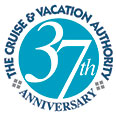Cunard's old-school travel continues tradition on Queen Elizabeth
By Karl Zimmermann
The Queen Elizabeth 'maiden world voyage' from start to finish was filled with Cunard tradition, including formal dining, lectures, extensive libraries and fireworks.
Reporting from aboard the Queen Elizabeth
I'm standing in front of the mirror in our stateroom, looking over my wife's shoulder and tying my black bow tie. It is our first sea day and the first of three formal nights on our leisurely eight-night early January crossing on Cunard Line's spanking-new Queen Elizabeth, on the way to New York from Southampton, England. The cummerbund is belted on, the studs are securely in place on shirtfront, but I've saved the neck knot for last, reminding myself of how my father first taught me how to do this on another transatlantic trip a half a century ago.
Black-tie affairs may be waning on other ships, but not on Cunard vessels, which, if anything, have become slightly more formal in recent years. How like Cunard to flout a trend. That charming defiance stems partly from Cunard's transatlantic mission, which dates to 1840, the year Samuel Cunard began sailing his ships across the Atlantic.
Our trip is the first leg of Queen Elizabeth's "maiden world voyage" and its first trip to New York, on the route once so busy with ships of many nations that it was called the "Atlantic Ferry." Scattered throughout the Elizabeth are paintings of the current and former fleet, photos of famous Cunard passengers, ship models and artifacts of all kinds. History and tradition are our constant companions.
The festivities as we left Southampton were brilliant, as the Brits (who dominated this crossing, 1,357 out of the total of 1,893 passengers) are fond of saying. After fireworks illuminated the foggy, rainy sky, Queen Elizabeth slid slowly by sister Queen Victoria, close enough you might have flung a baseball from deck to deck. Both ships' whistles sounded again and again in a spine-tingling mutual salute. We passengers waved from balconies and decks, and when the whistling stopped, cheers from both Queens echoed across the water.
The Queen Victoria would shadow us across the Atlantic, moving away only when the fog rolled in or the seas became seriously rough. Almost exactly three years earlier, my wife, Laurel, and I had made the same crossing, that time aboard the then-new Victoria, accompanied by the iconic Queen Elizabeth 2, on the verge of retirement.
Sailing with us then and now were a clutch of friends, Cunard devotees. Naturally we and others compared the sister ships, more similar than different, though the Elizabeth's dcor emulates the Art Deco aesthetic of the first Queen Mary and Queen Elizabeth, and the Victoria's dcor is, not surprisingly, Victorian. For me the Elizabeth's highlight is a 19-foot-tall marquetry panel above the sweeping staircase in the Grand Lobby. It depicts the first Queen Elizabeth ship, with inlays of nine rare woods typical of use aboard the original ship.
"Cunard," Bill Miller told me when we chatted in the ship's glass-domed Garden Lounge, "is for people who like old-school travel." Miller, whose moniker is "Mr. Ocean Liner" and who has made about 400 voyages on many lines, was one of five lecturers on our crossing, and these lectures (three or four most days) are a Cunard hallmark. Others speakers included Terry Waite, the former hostage negotiator and later hostage, and Ted Scull, a maritime expert like Miller but who on this crossing provided an introduction to New York City for the British passengers.
"Cunard is the most cerebral cruise line," Miller said. "Its lecture programs are among the most enriching on the high seas, and it has the biggest libraries." On the Victoria and Elizabeth they're two decks tall, connected by a spiral staircase. The Queen Elizabeth, still building its collection, now shelves 6,000 books; the Victoria has 8,000, and the Queen Mary 2, 10,000.
"During the day you see more people carrying books than on any other line," Miller said, "and at night more tuxedos and war medals. The Brits love those." The QM2 also has a planetarium.
I asked Scull's opinion on two sometimes controversial issues. Transatlantic crossings were traditionally multi-class, in later years always "first" and "tourist" with "cabin" often in the middle. Cunard retains a vestige of this, with those in the best cabins dining in the open-seating Princess Grill or Queens Grill and having access to an exclusive lounge and decks.
"There are people who want to pay for a more luxurious and intimate setting," he said. "I have no problem with that."
And how about all the proud Britishness, the naming by Queen Elizabeth II, whose brand-new portrait hangs aboard, considering that Cunard is one of seven lines under the umbrella of an American company, the outgrowth of Carnival Cruises?
"I think the parent company has wisely let each brand keep its independent identity," he said. "That way there's a line for everyone."
On Day 6 of the voyage, about 6:30 in the morning, I get an unrequested wake-up when my water glass slides off the table and into bed with me. While I mop that up, the ice bucket rockets off the coffee table and empties its slush on the carpet. The winter North Atlantic is kicking up its heels, and the Queen Elizabeth is pitching and rolling but holding its own. The seascape is a magnificent muddle of dark gray streaked with white. Pink clouds on the eastern horizon suggest more weather ahead.
The other unmistakable portent is of journey's end. In less than 48 hours we'll have steamed up the Hudson River and be fast at the Manhattan Ship Terminal next to the Queen Victoria. QM2 will be docked at the Cunard terminal in Brooklyn's Red Hook section.
More than 1,100 passengers will disembark from Queen Elizabeth, our small group included, and when the ship refills there will be substantially more Americans aboard. (On a typical QM2 crossing the passenger list will typically be 50% British and 40% American. On cruises from the U.S., the balance will shift.)
That evening the three Queens rendezvoused in Upper New York Bay, off the Statue of Liberty. Such a meeting happened only once before, three years ago, and the third Queen then was the QE2. The Empire State Building was bathed in Cunard Red for the occasion. Fireworks again illuminated the sky.
Who but Cunard could pull this off? "If three other ships met in New York," Miller told me, "no one would care."

With each issue of Ultimate Experiences Online, you’ll enjoy a collection of articles, slideshows and videos that we will inspire you to make your travel dreams a reality.

To help you discover ways to explore the world, we're pleased to share our The Travel Magazine Online.
 Save money and escape the crowds. Hot Deals and multi-port packages. Savings of up to 50%!
Save money and escape the crowds. Hot Deals and multi-port packages. Savings of up to 50%!

Our free app that allows you to carry all of the destination information you need while traveling, right in your pocket!

We recommend optional travel insurance that protects you in the event of having to cancel your trip avoiding travel vendor cancellation policies and more!





